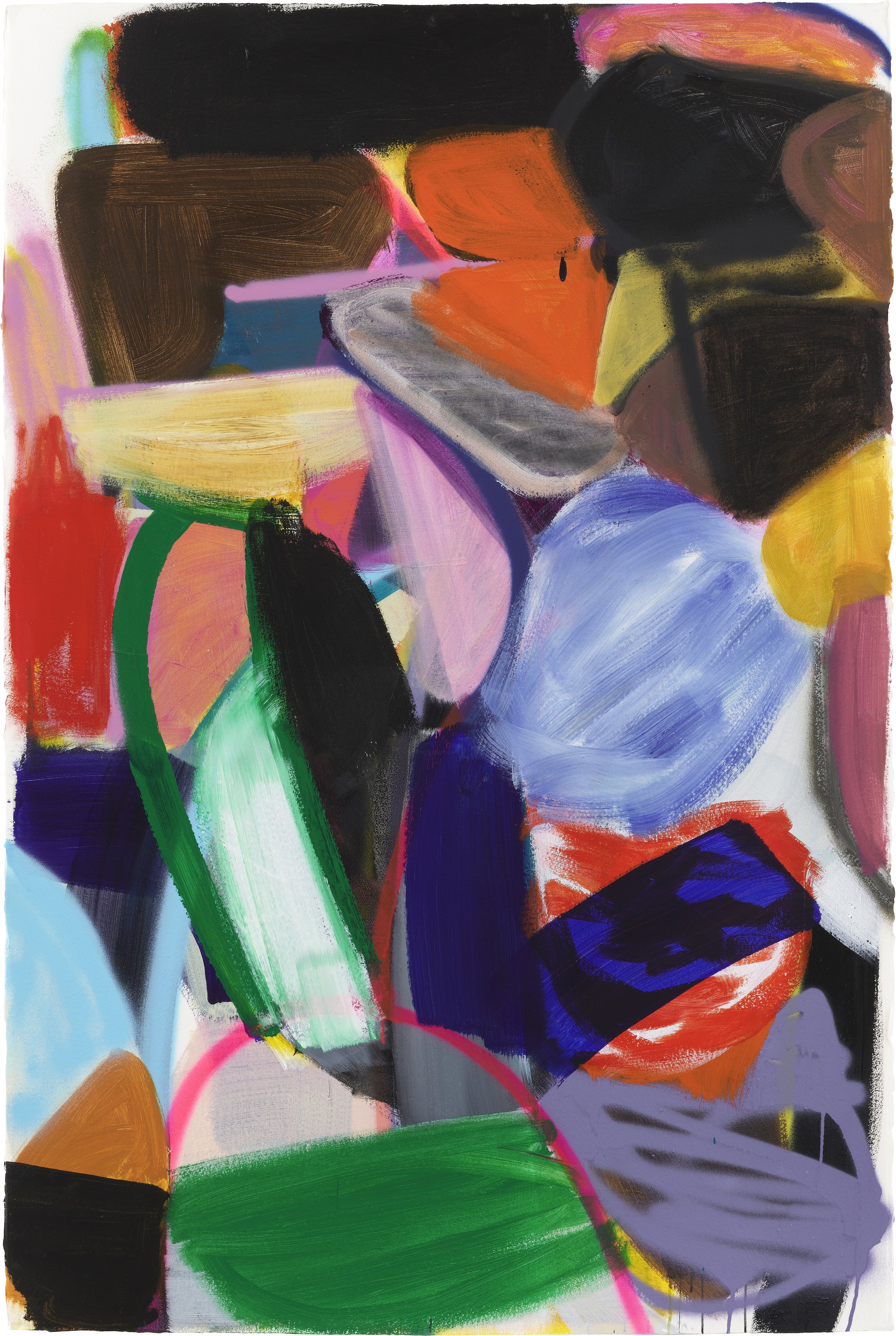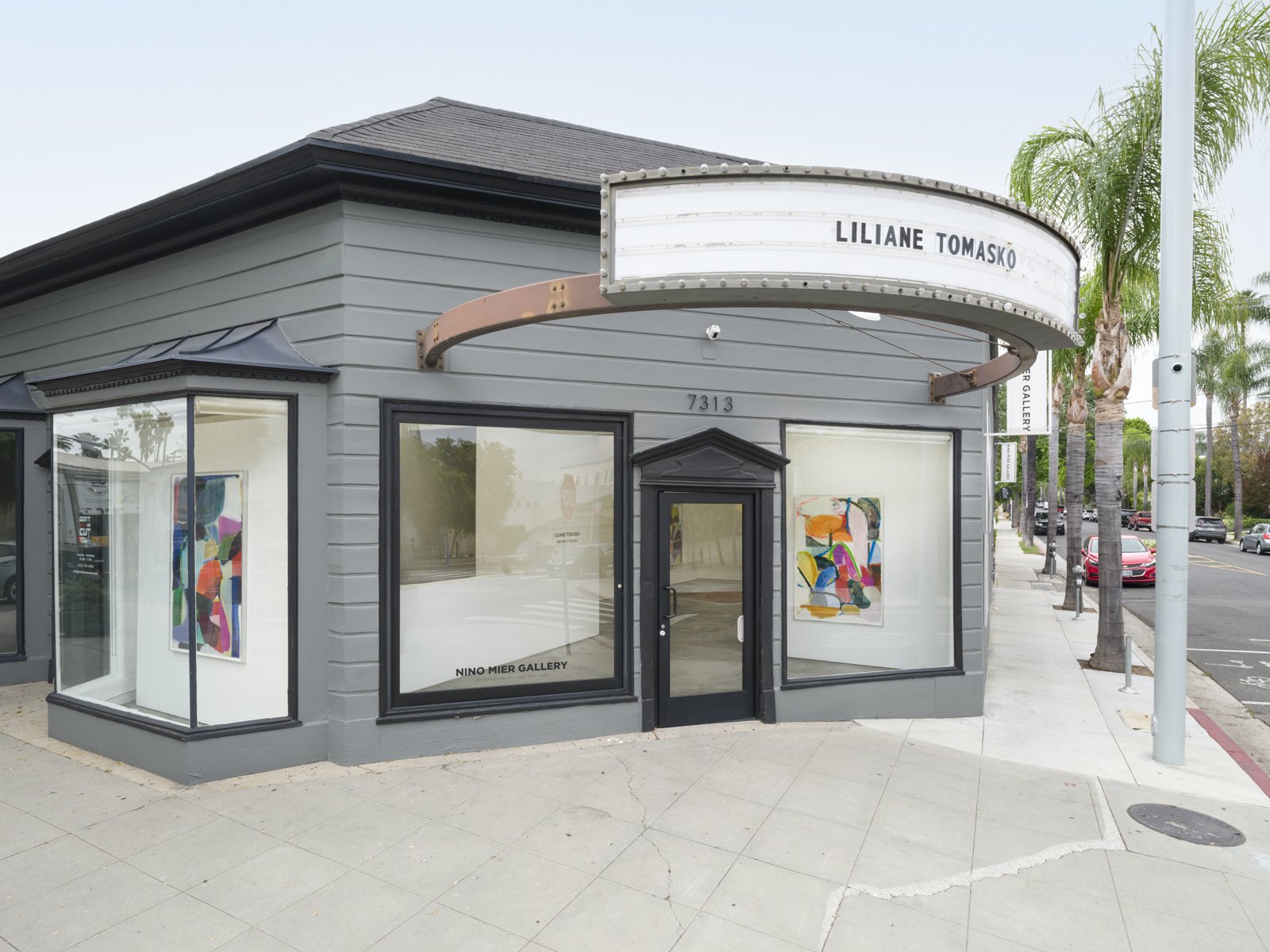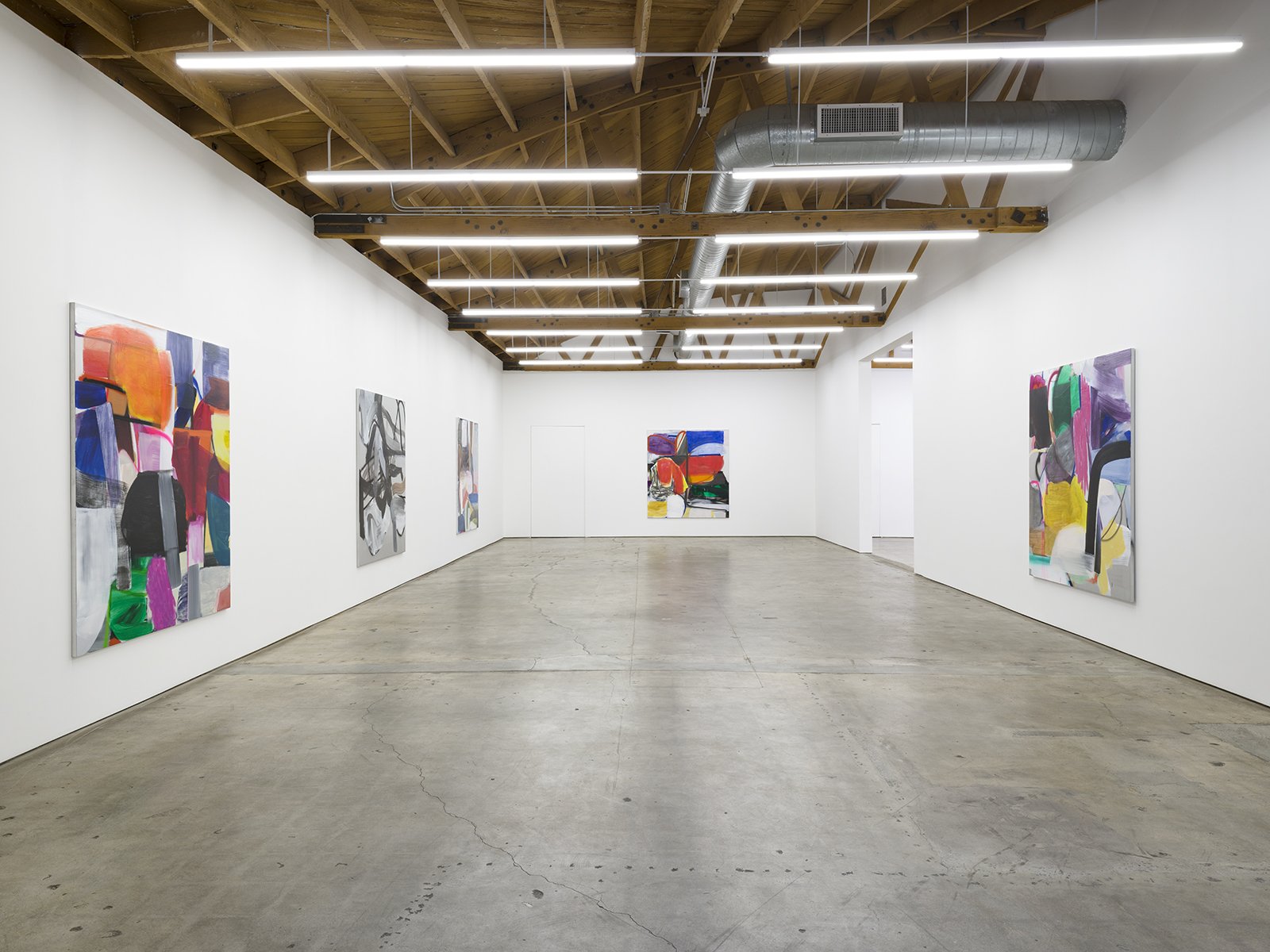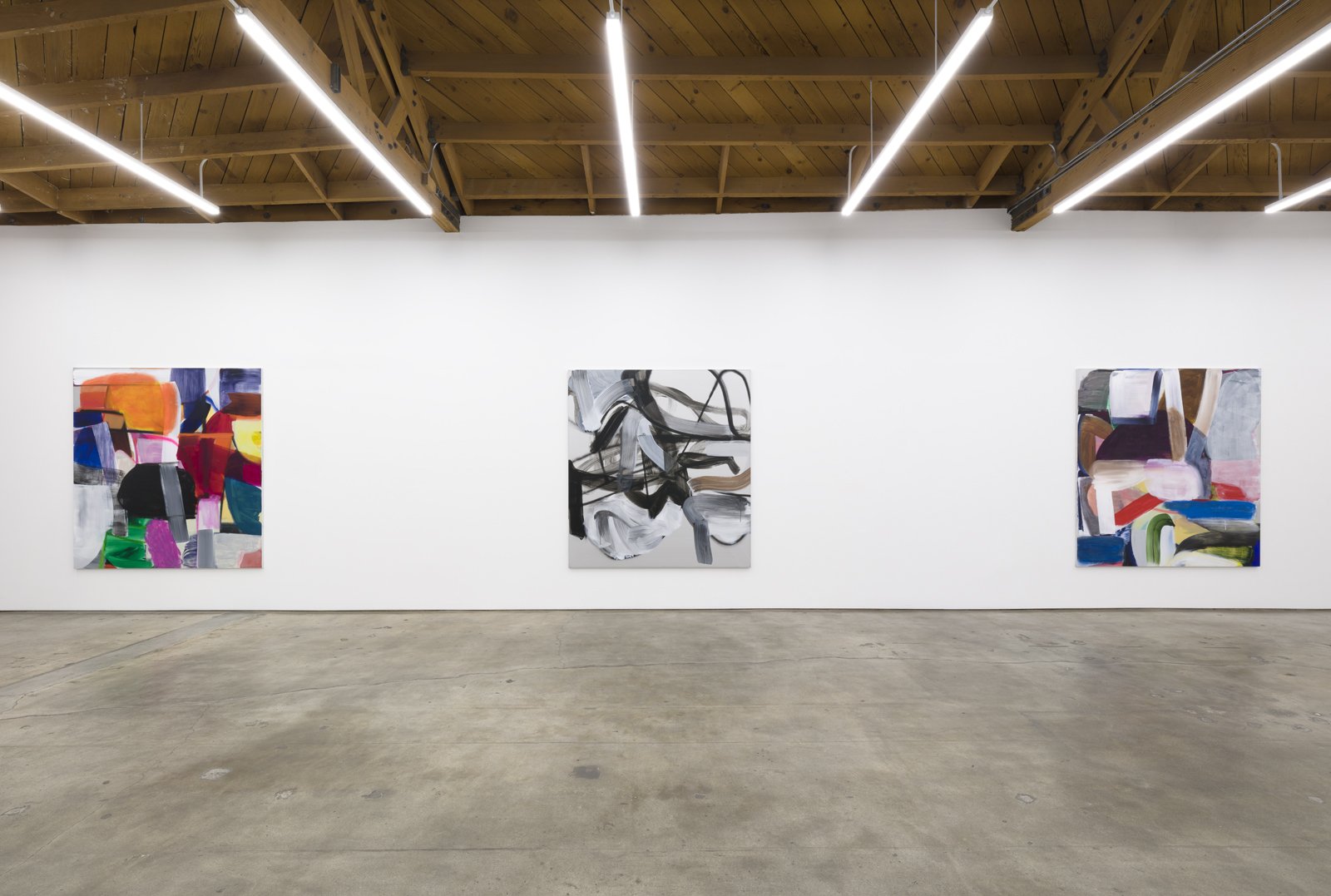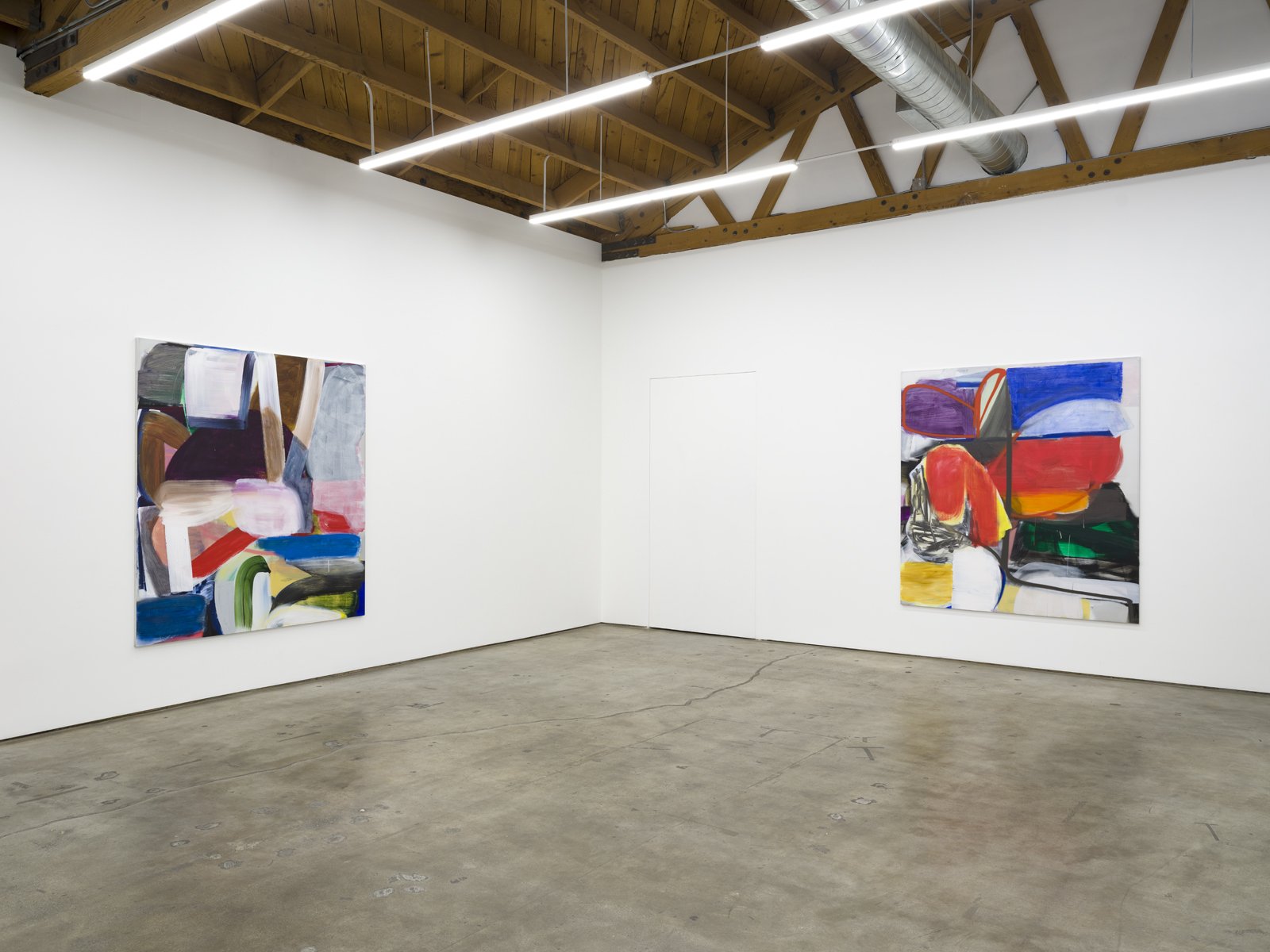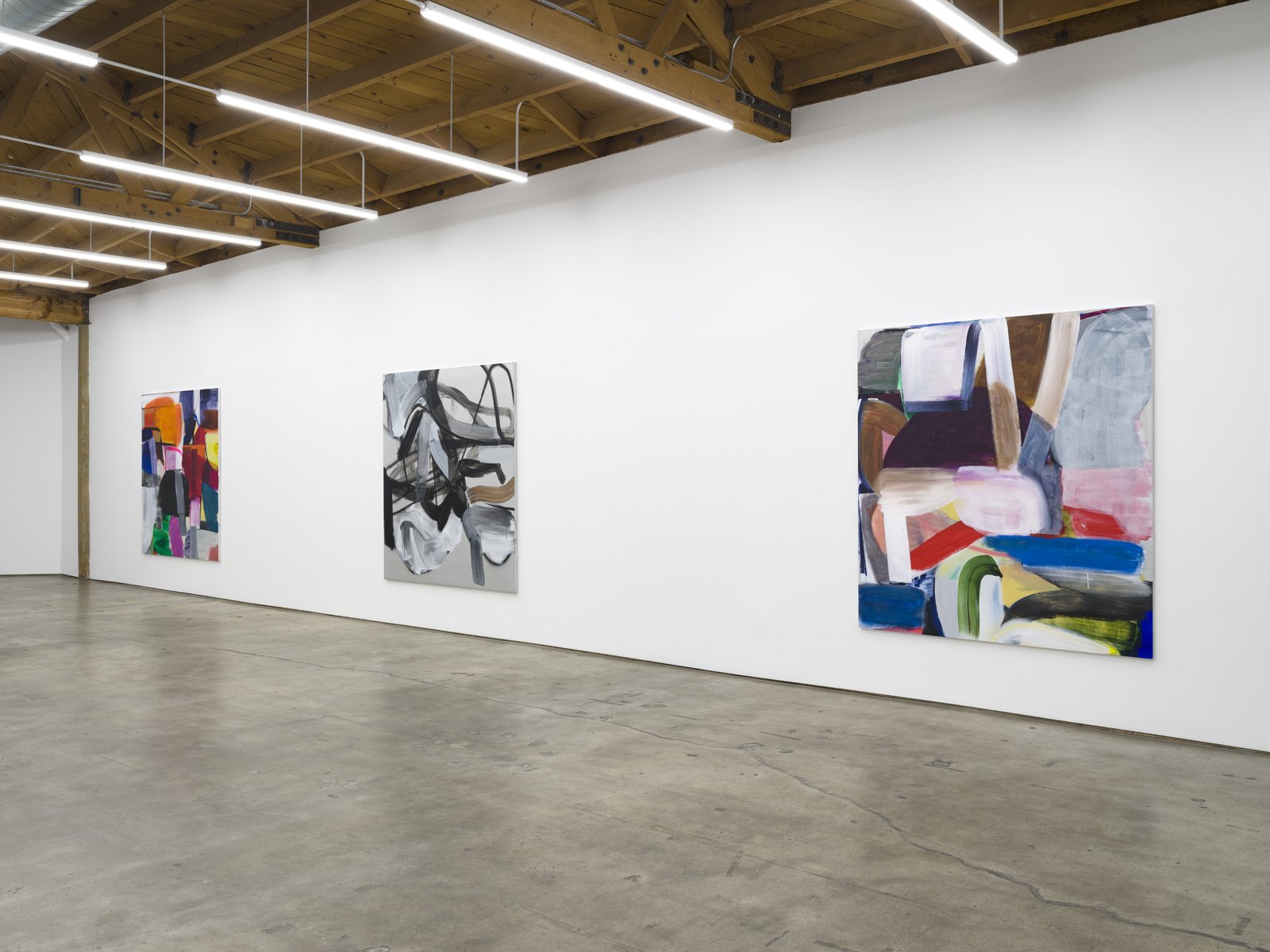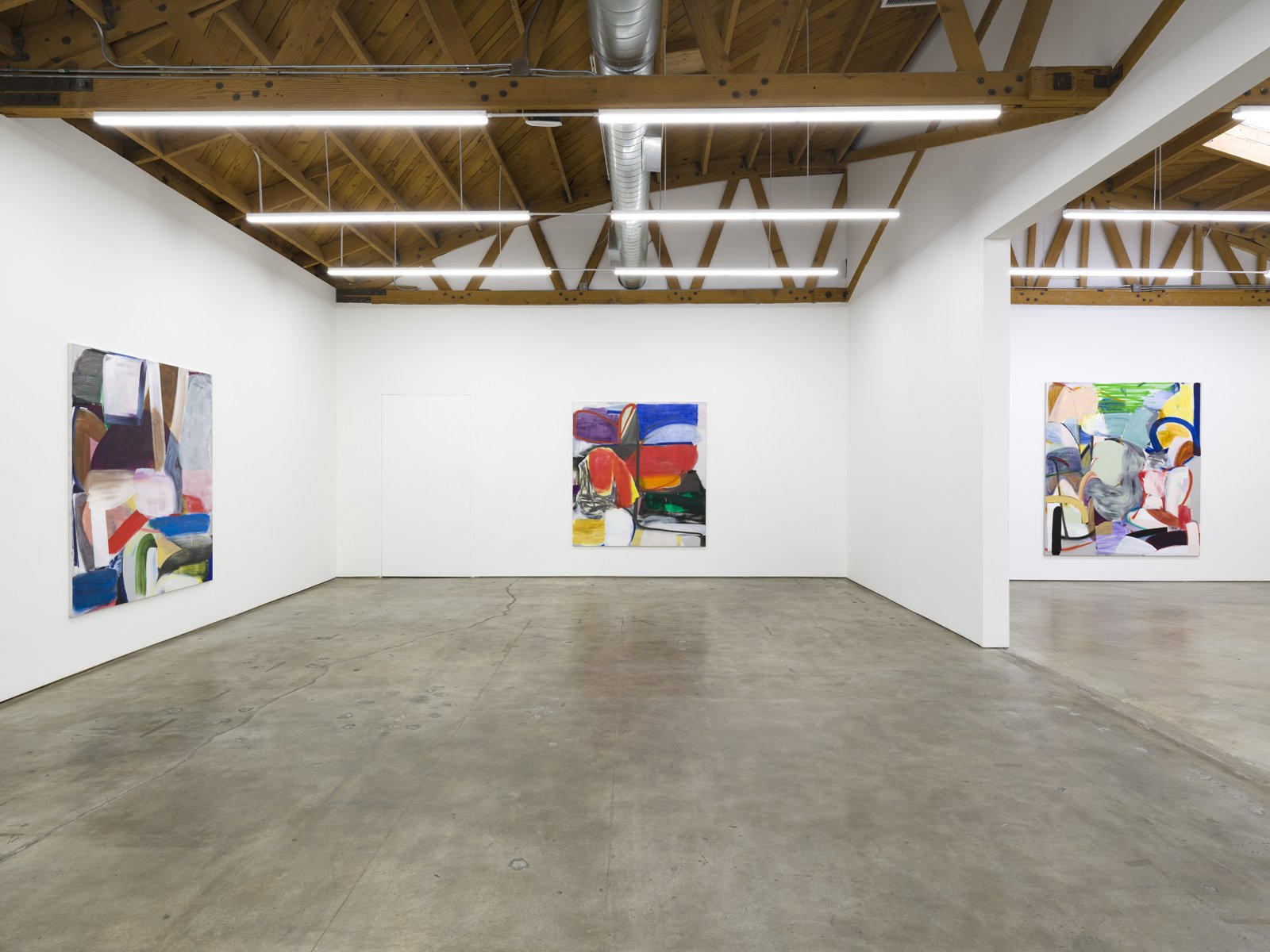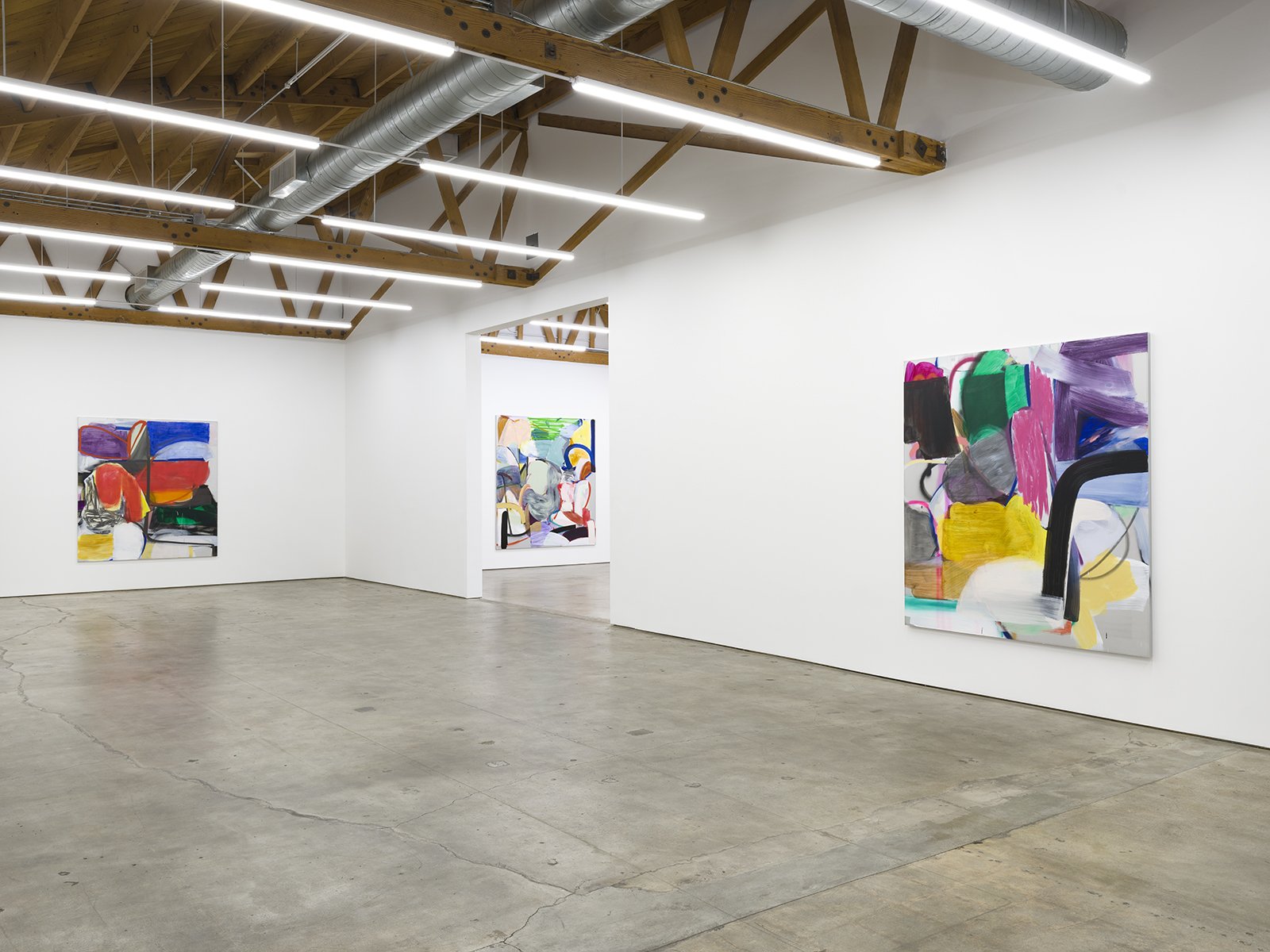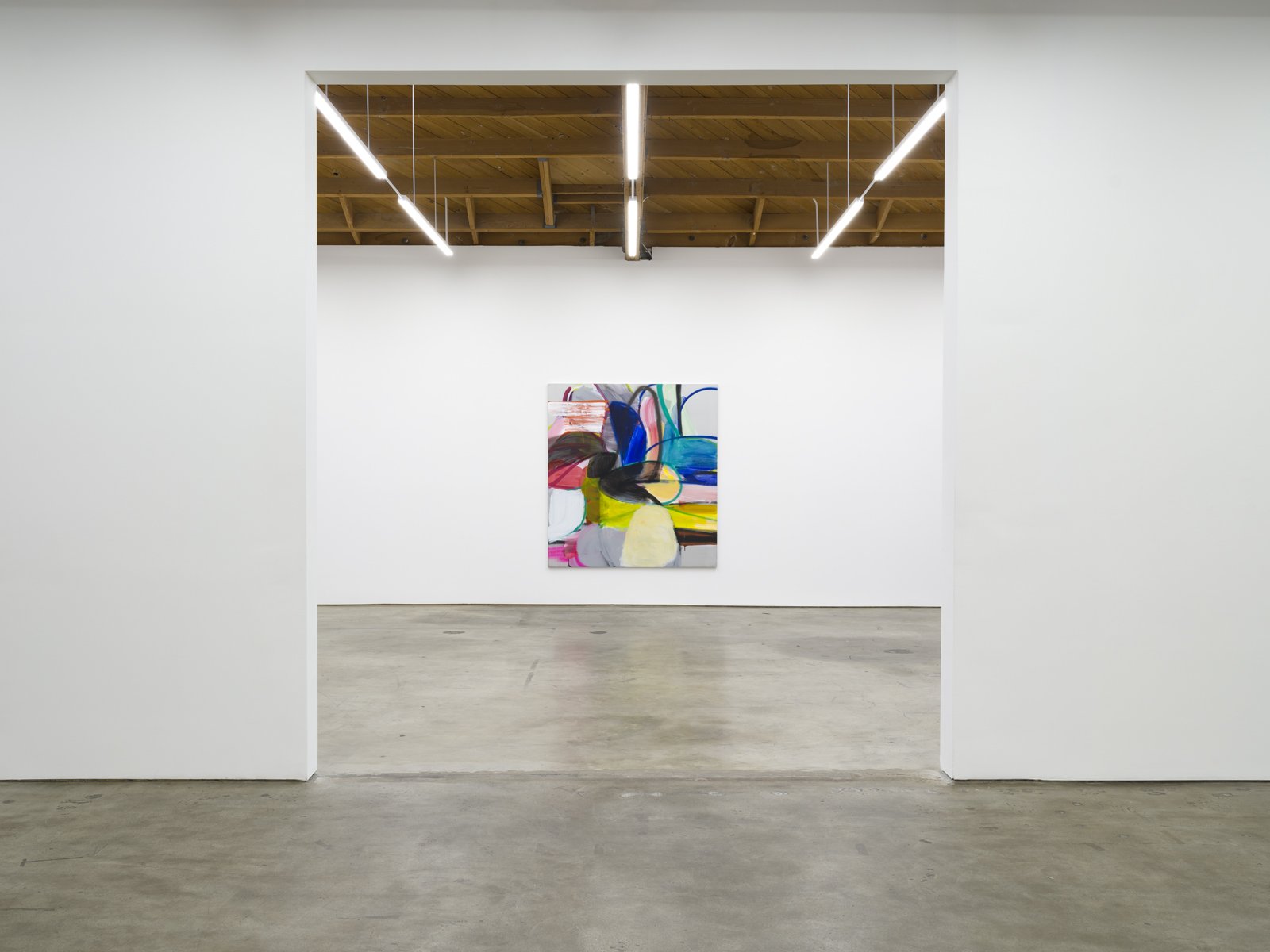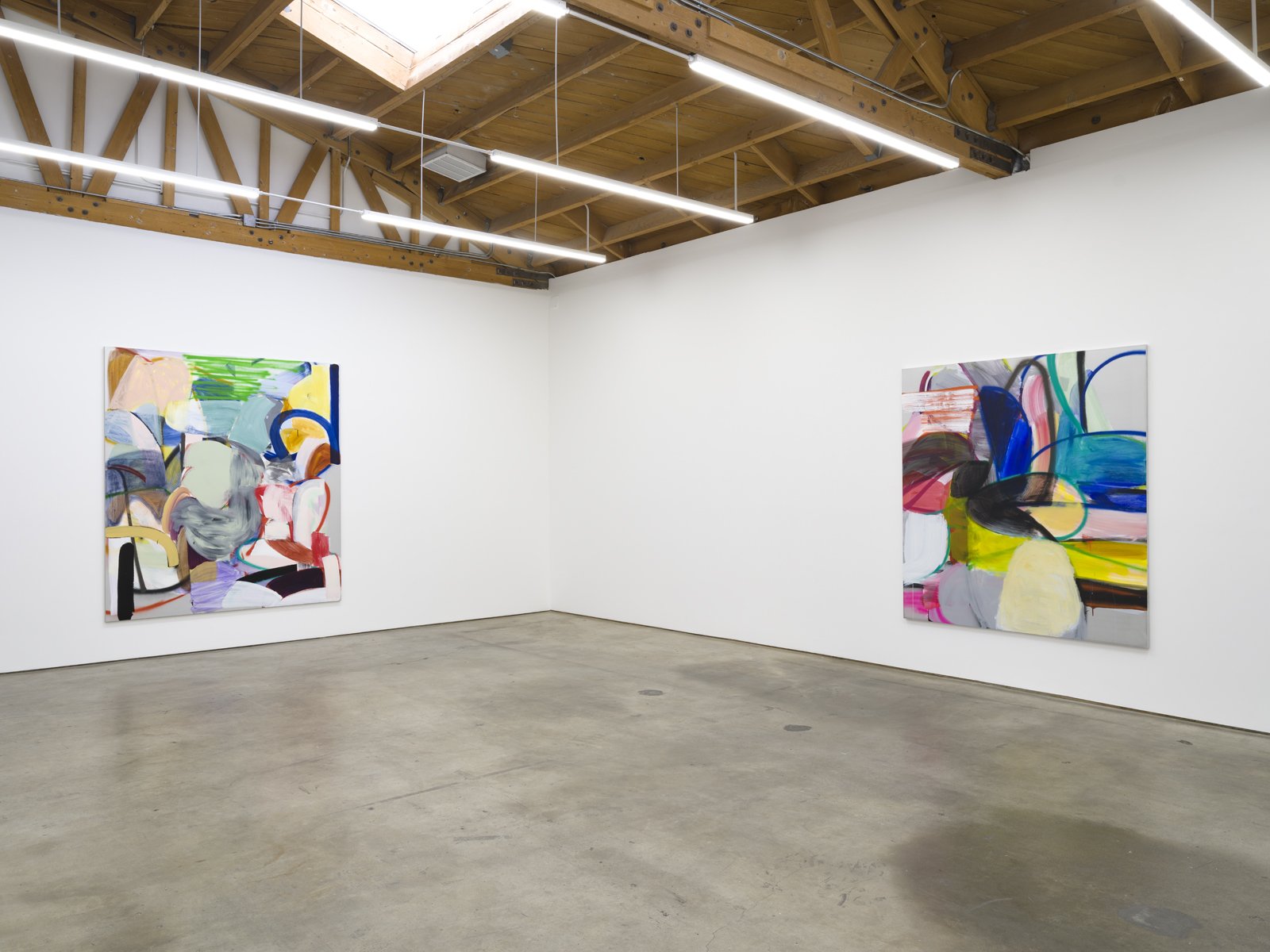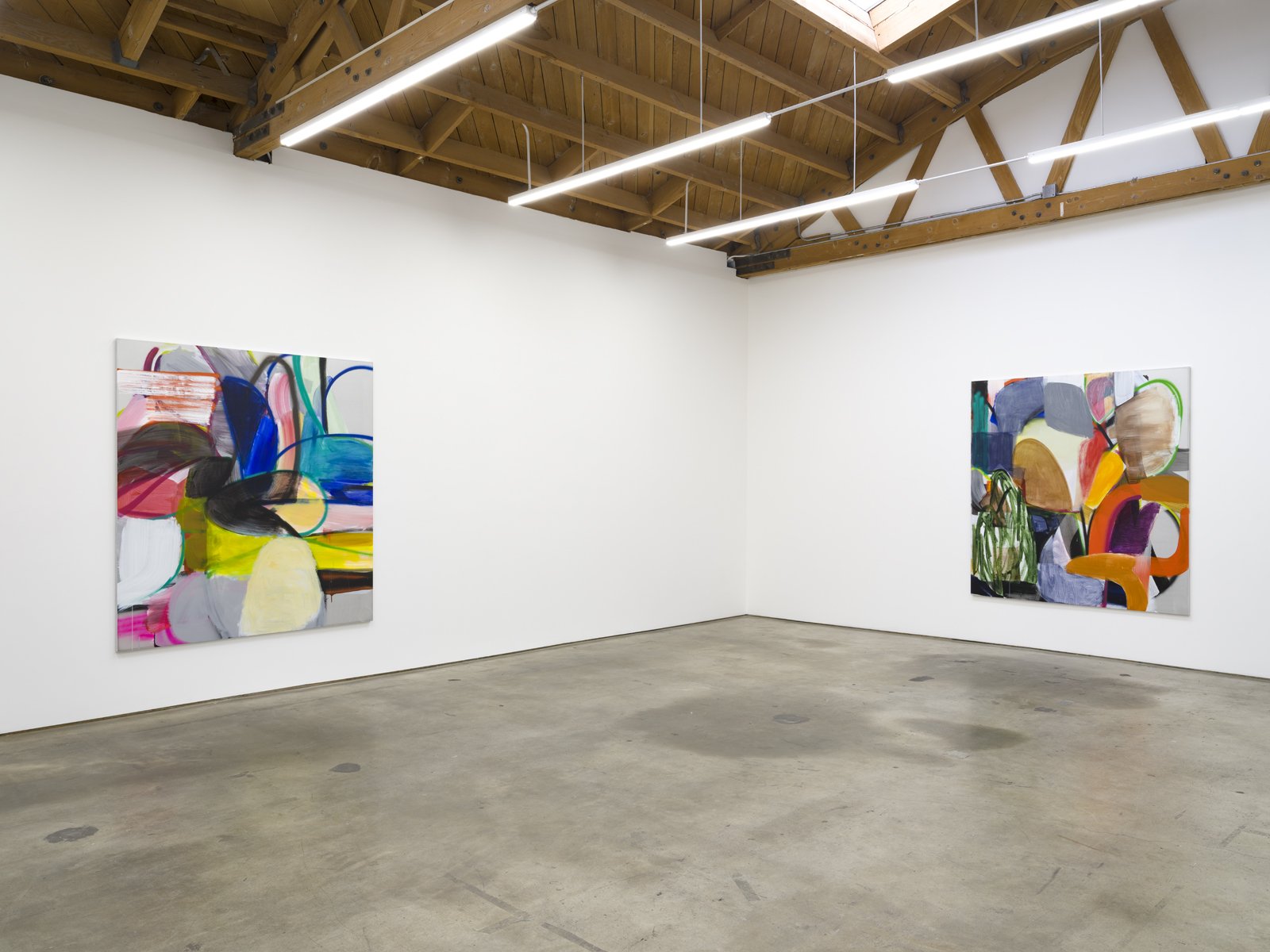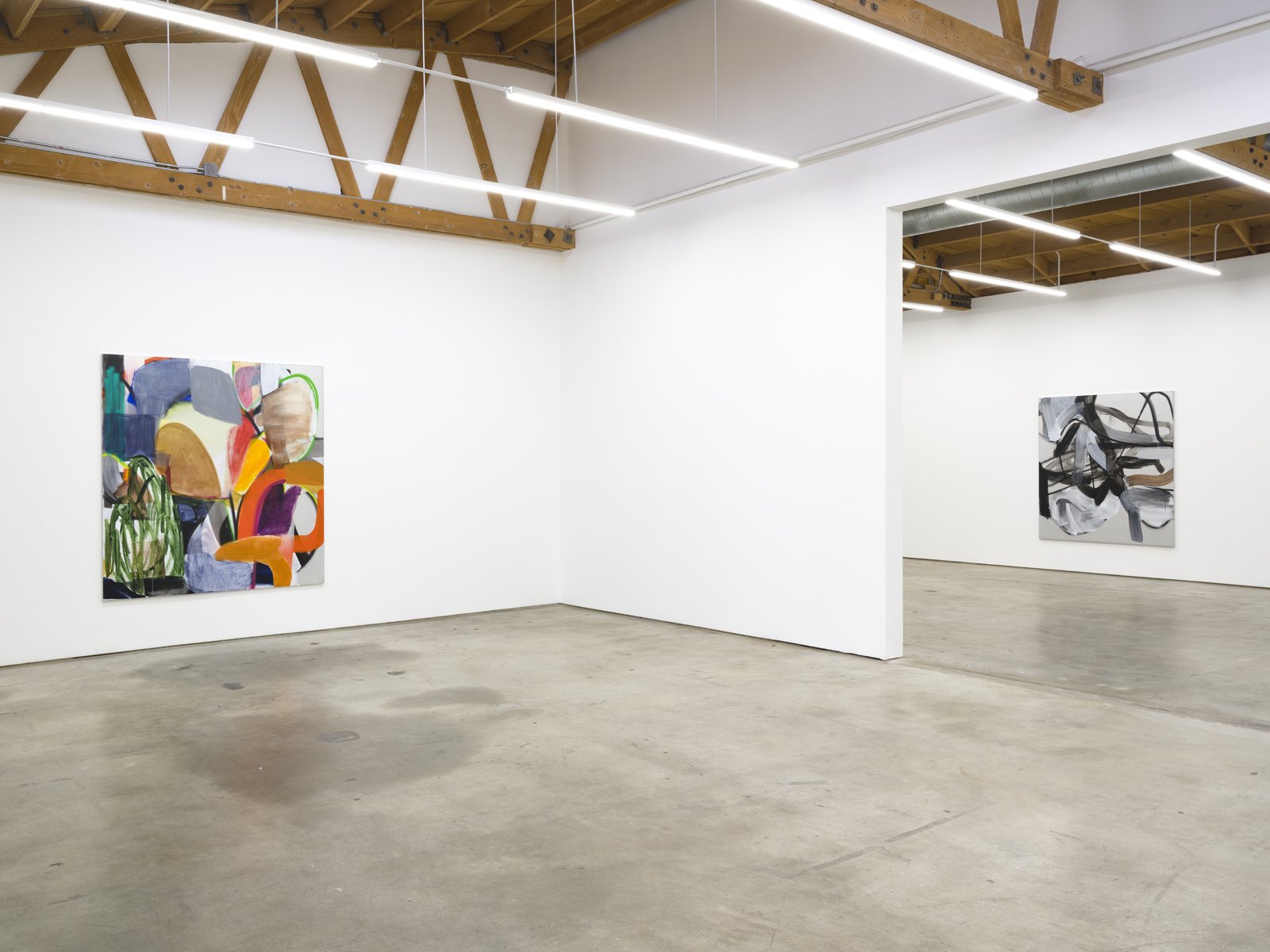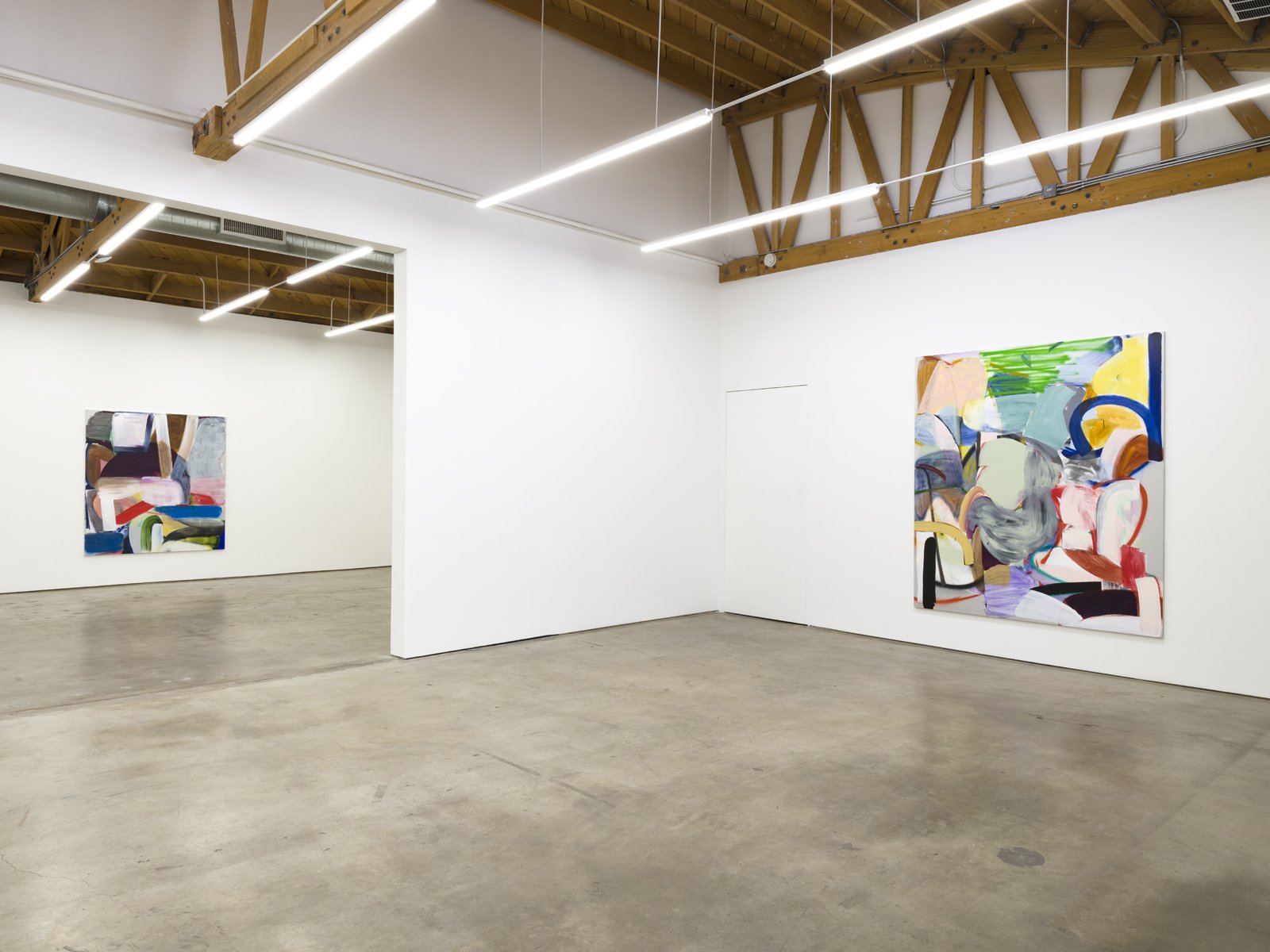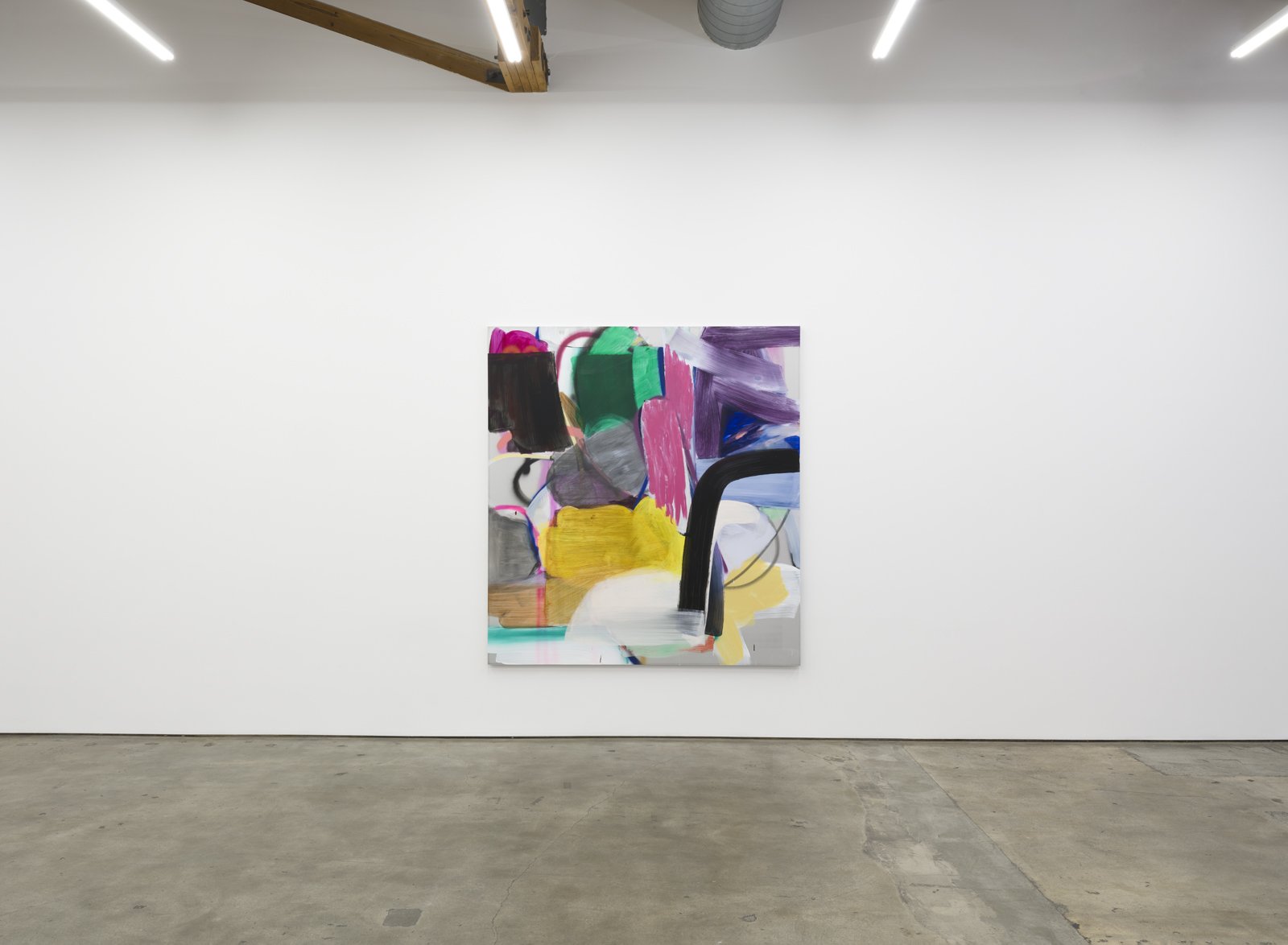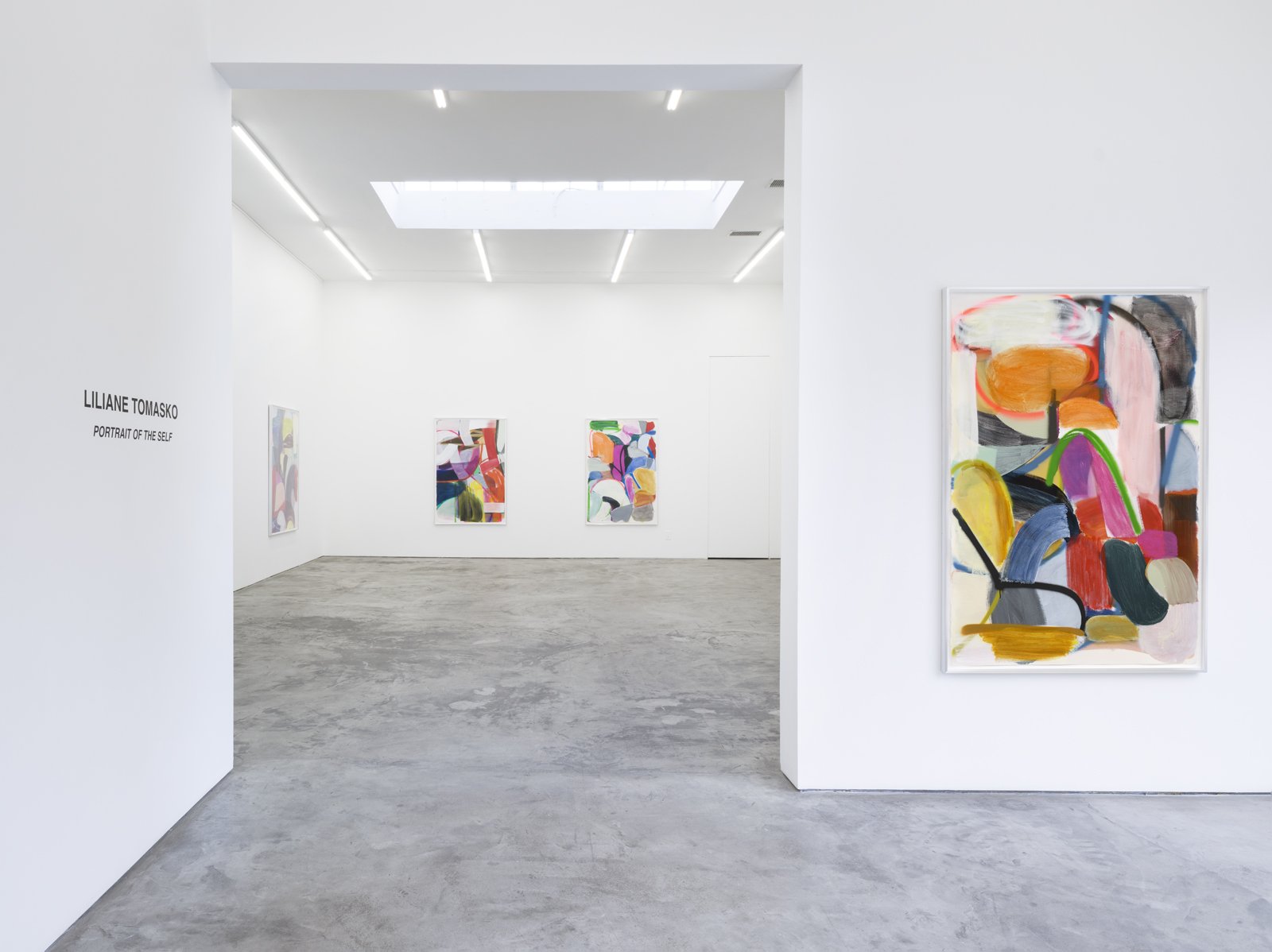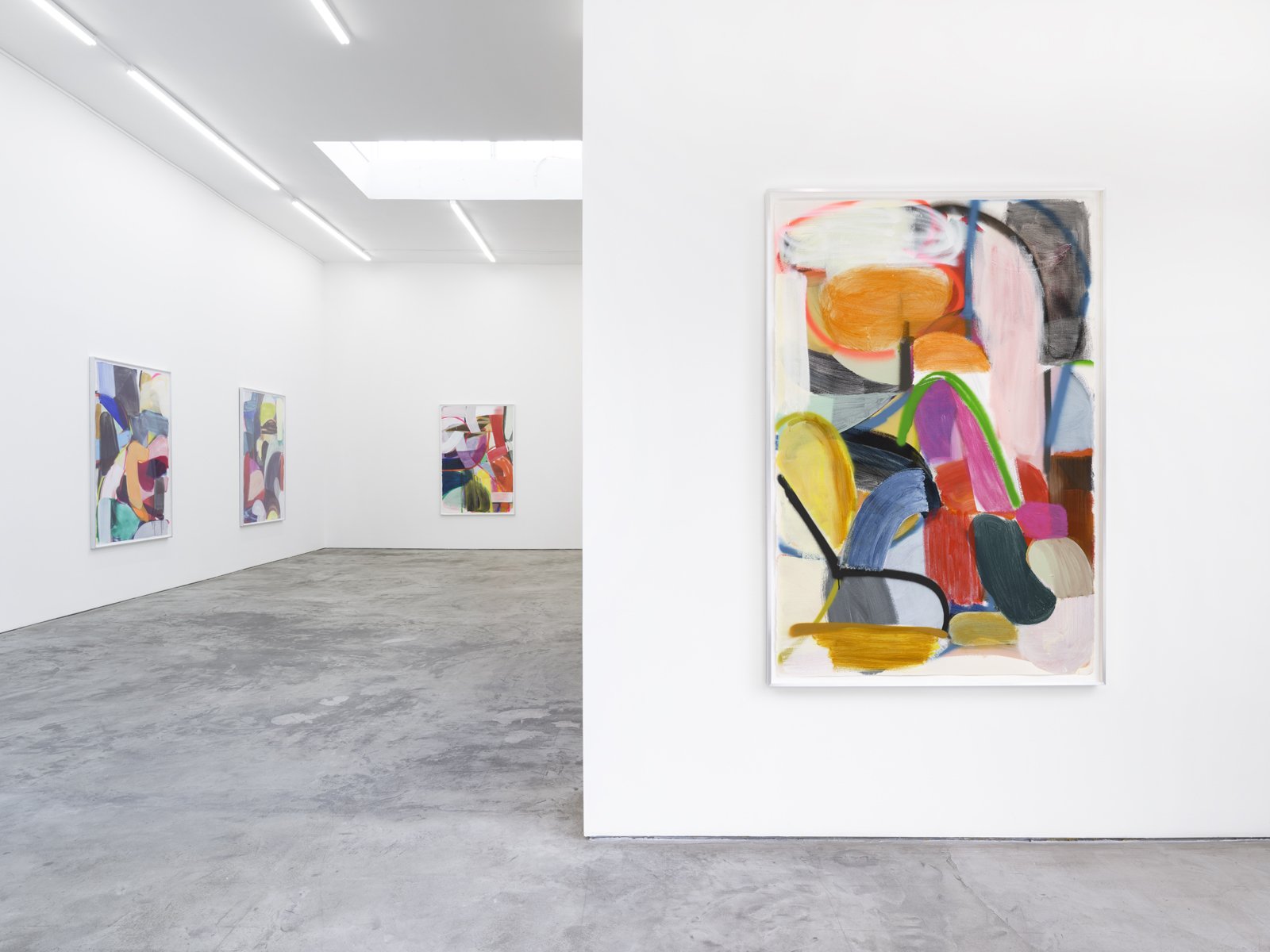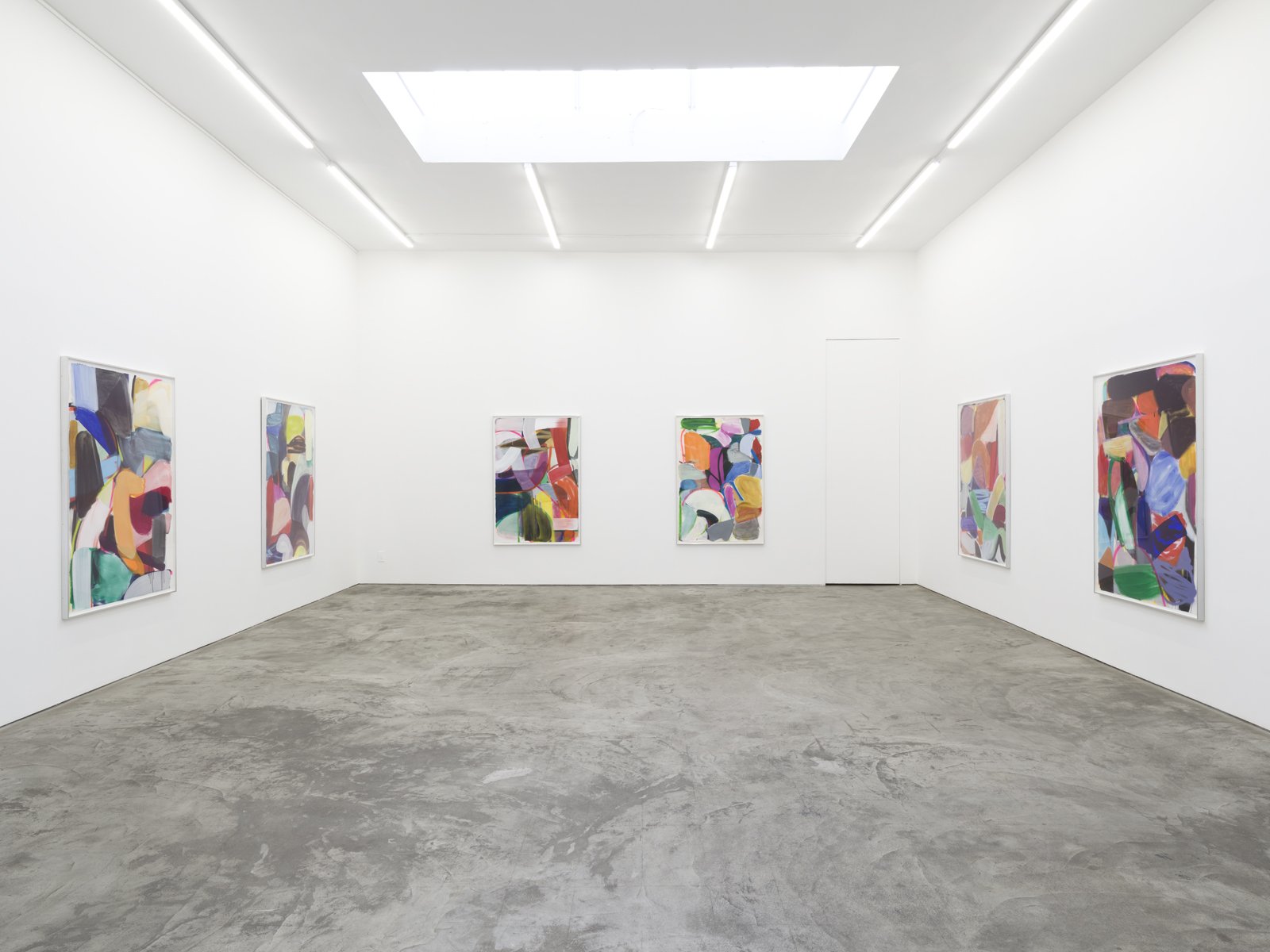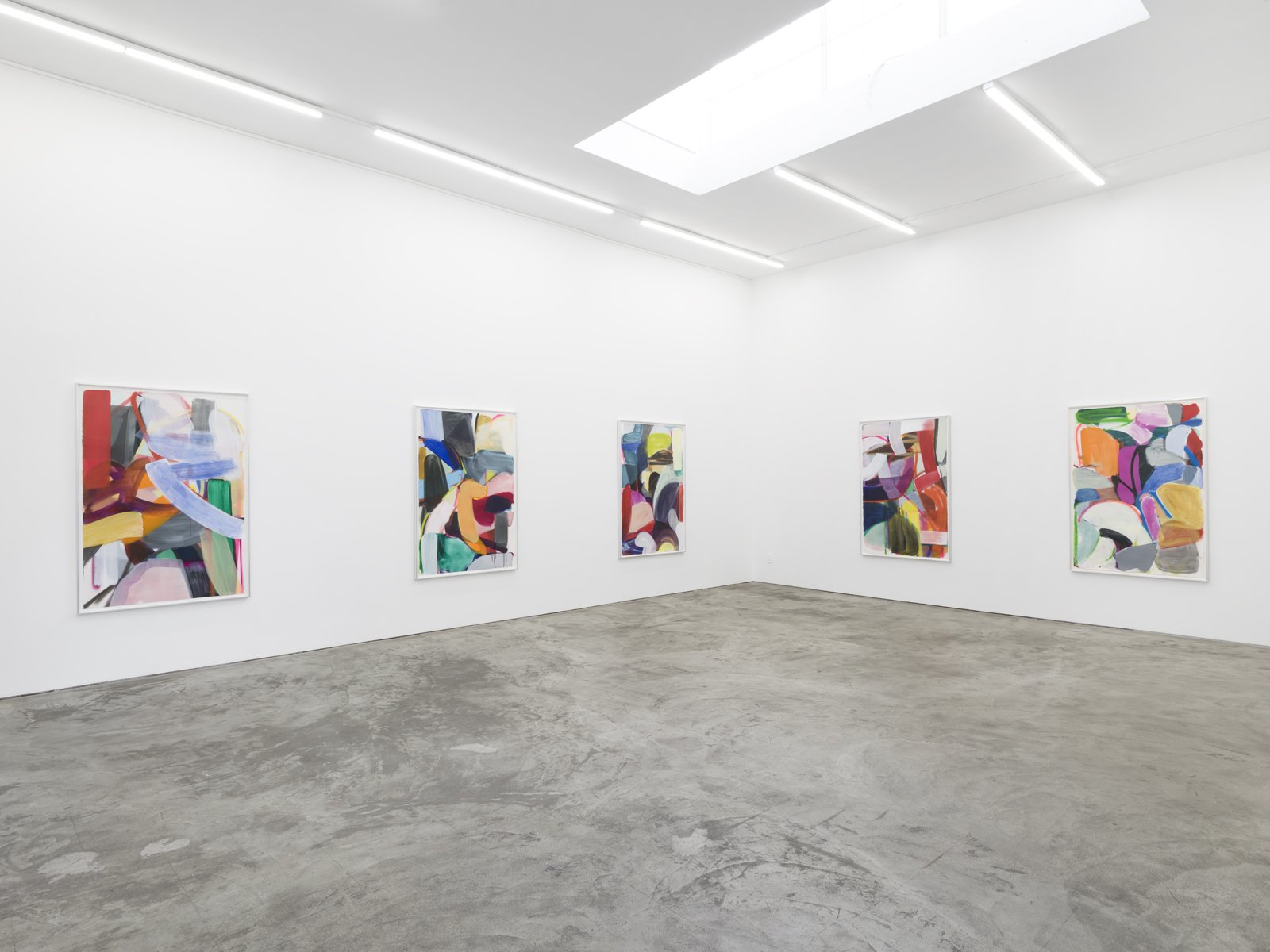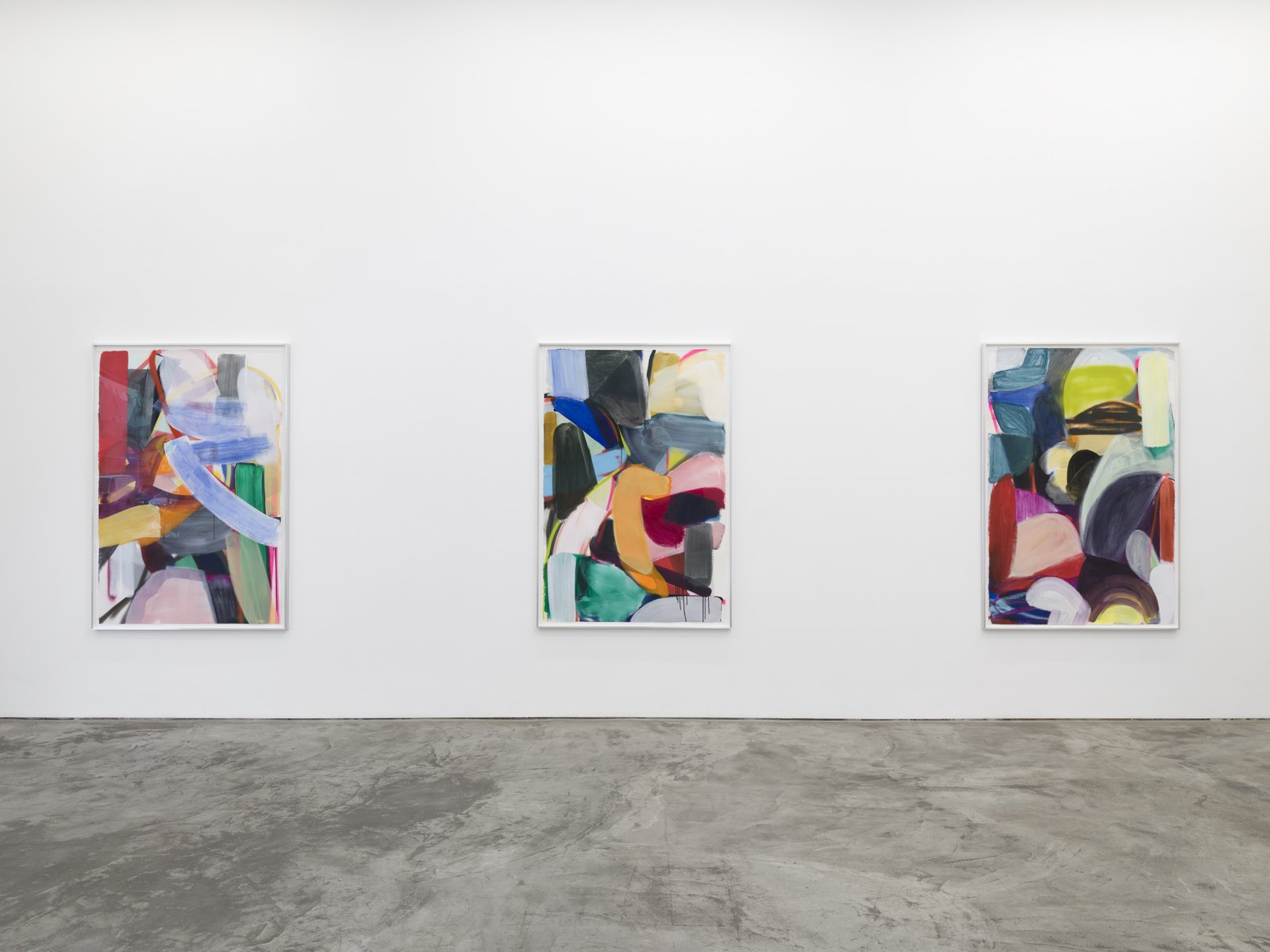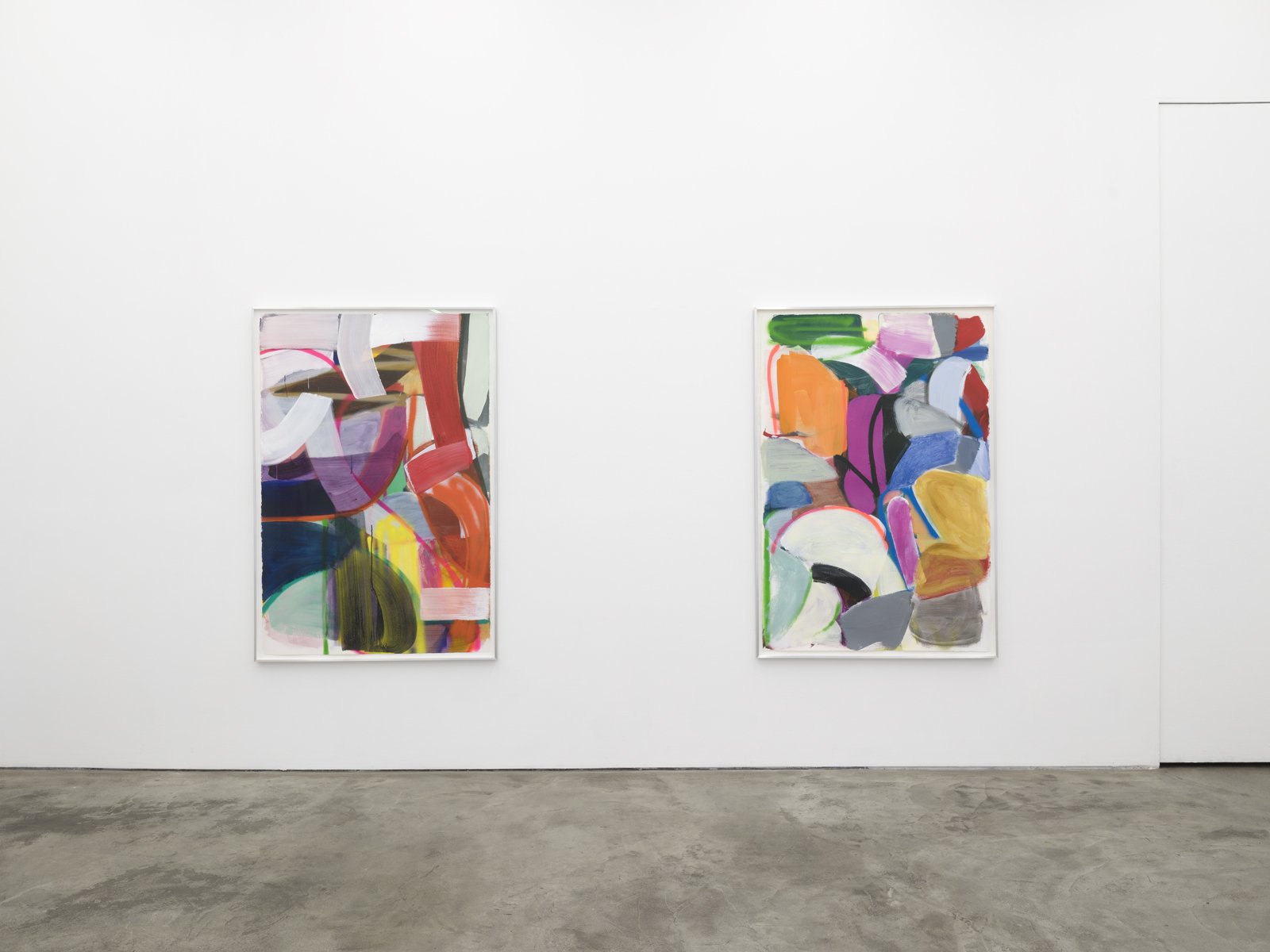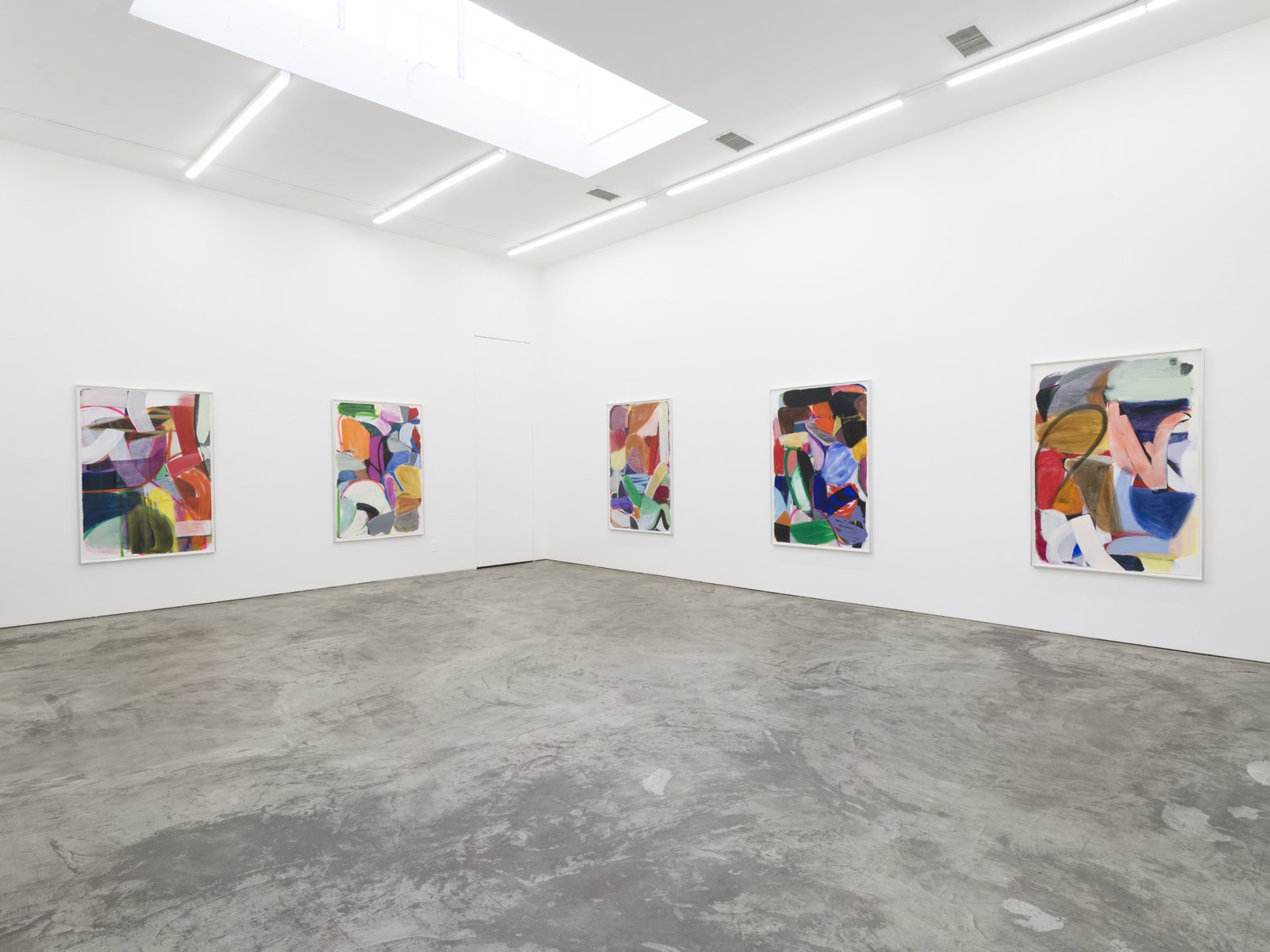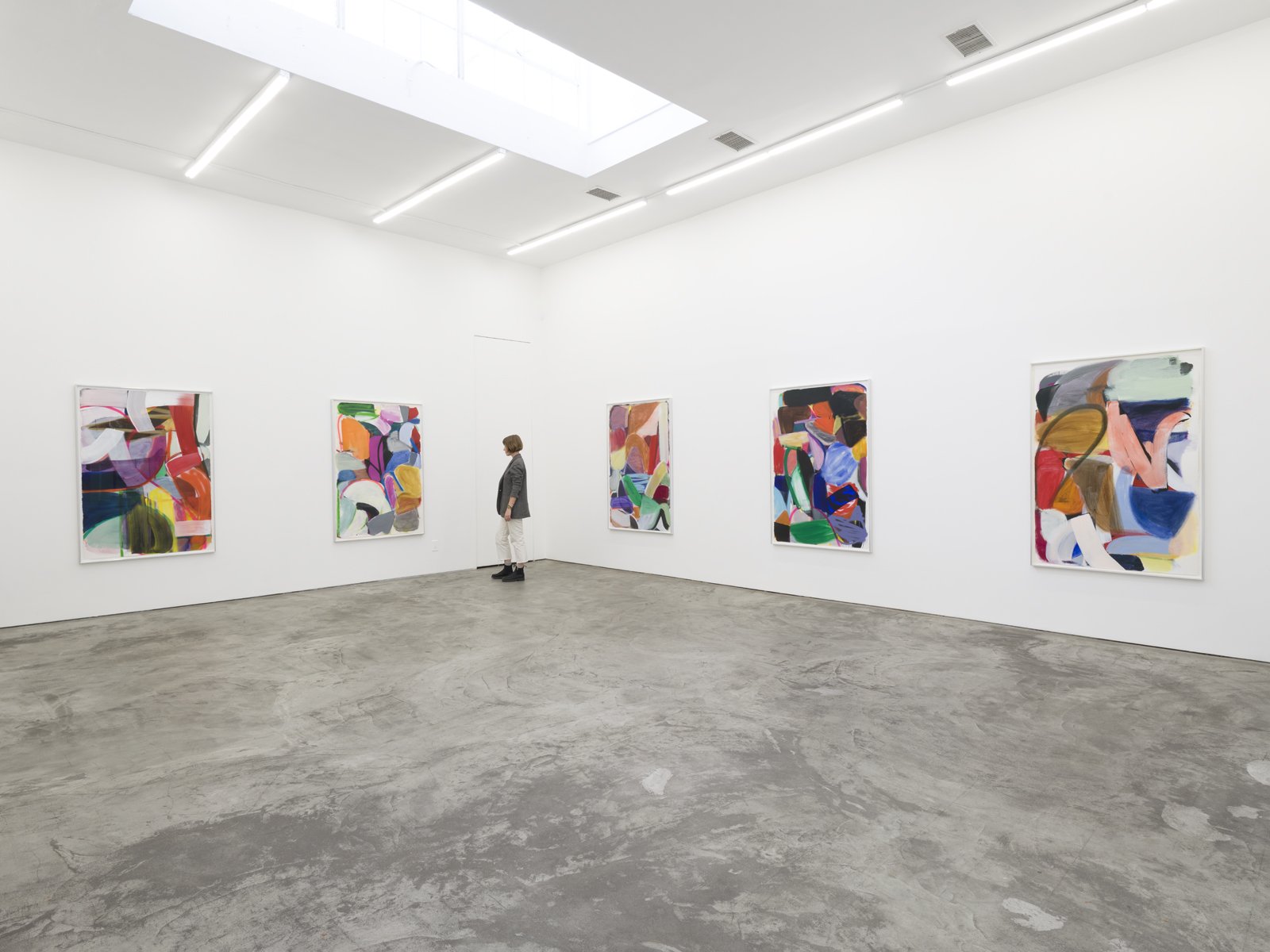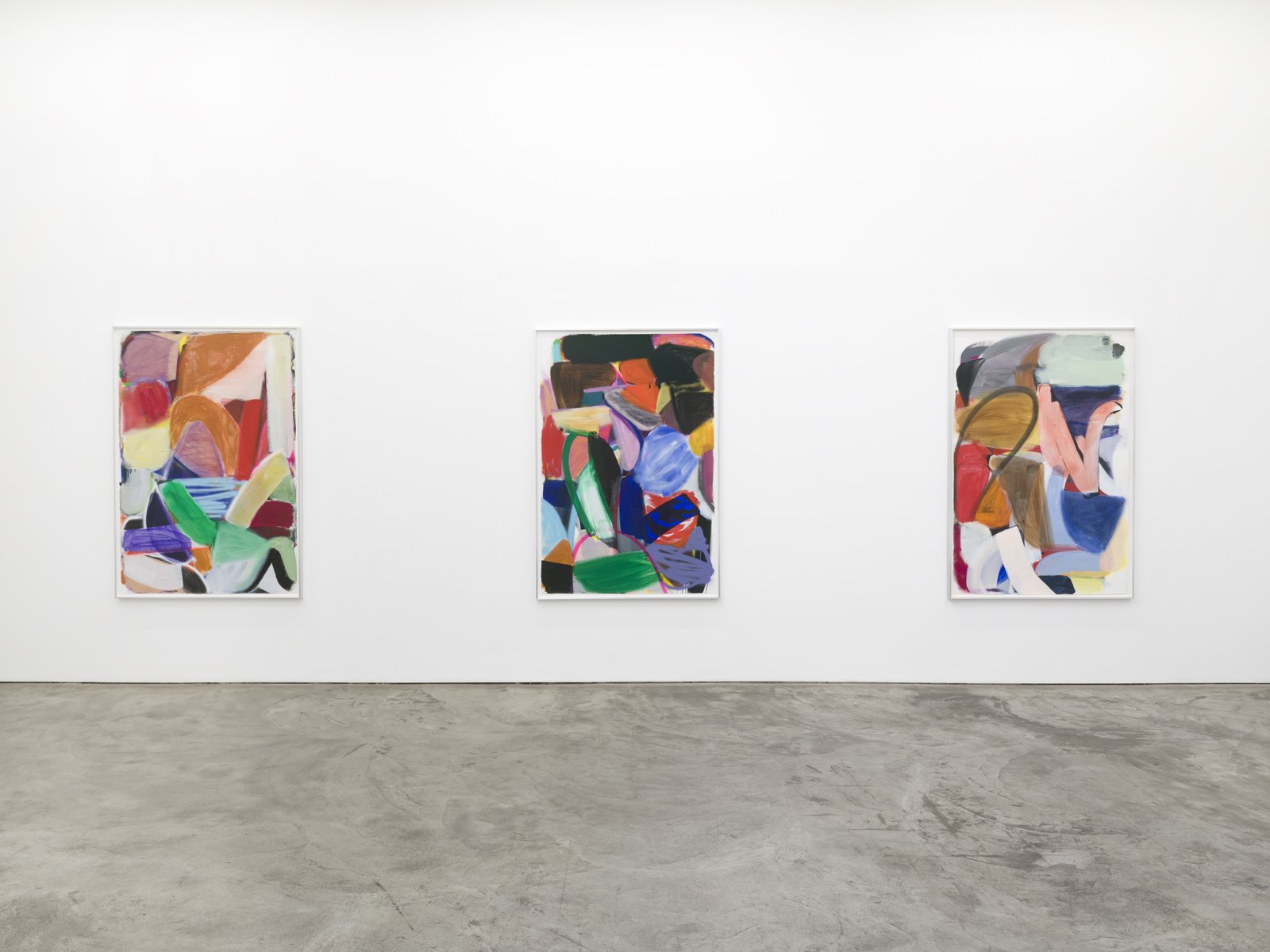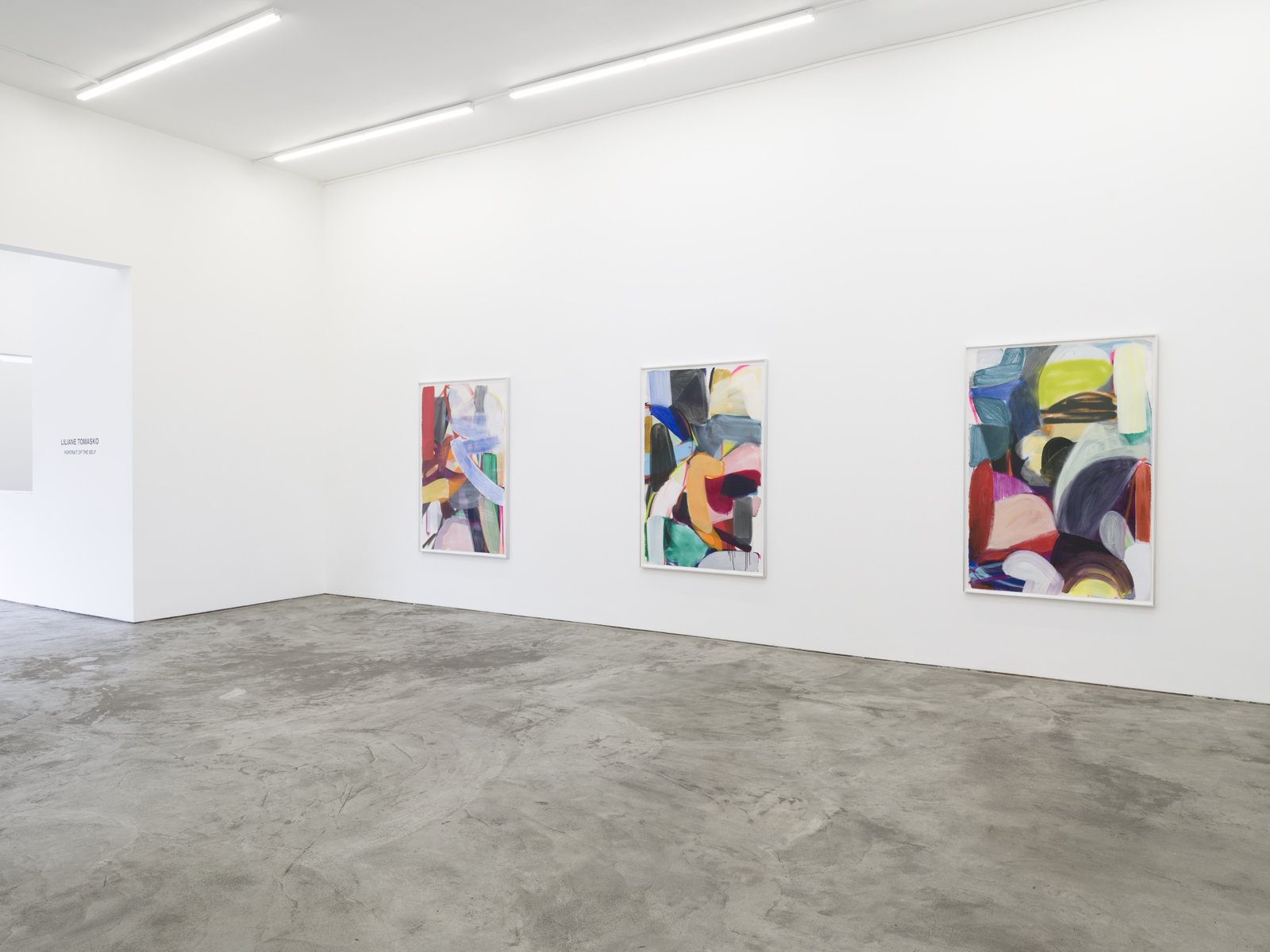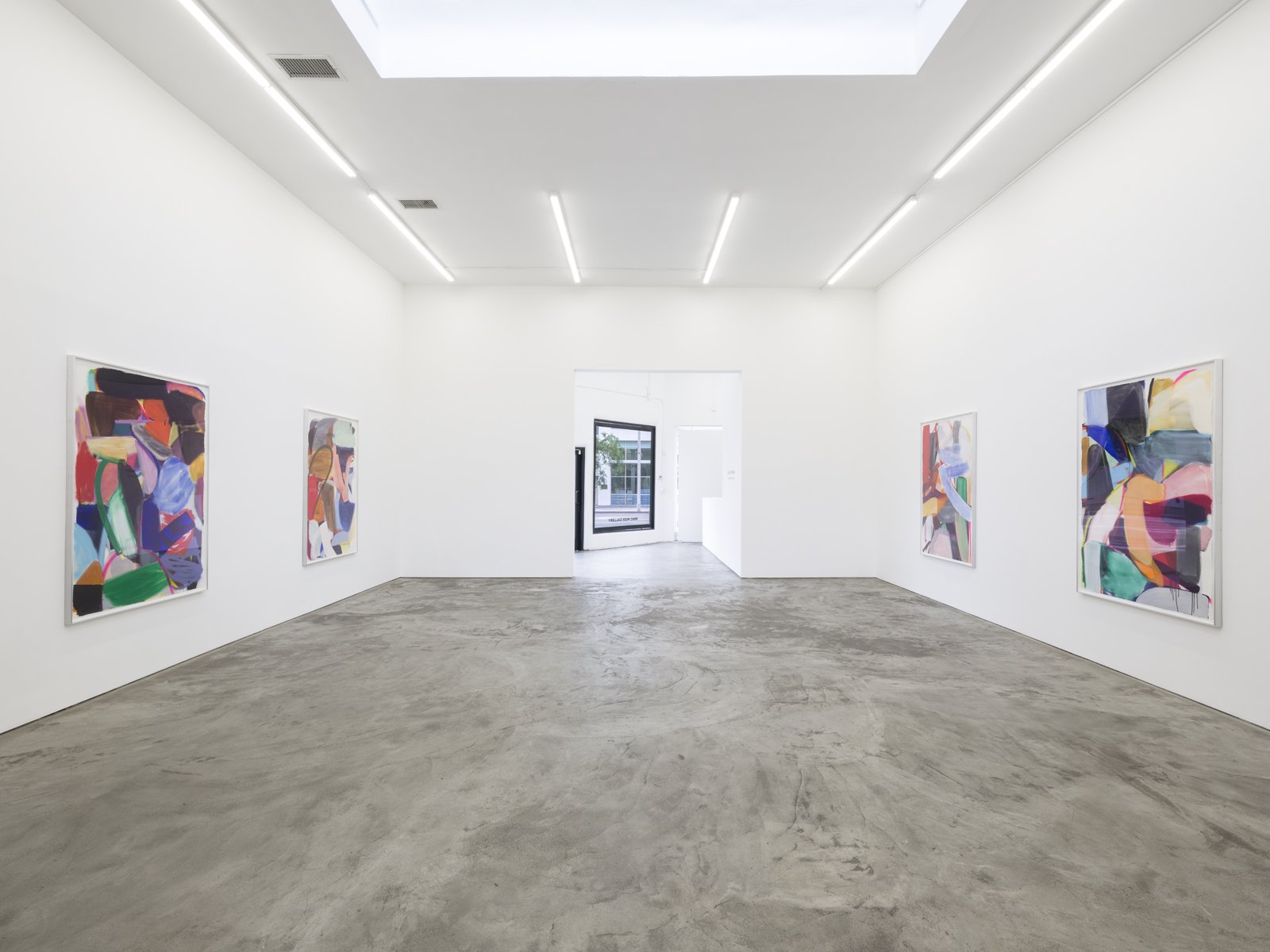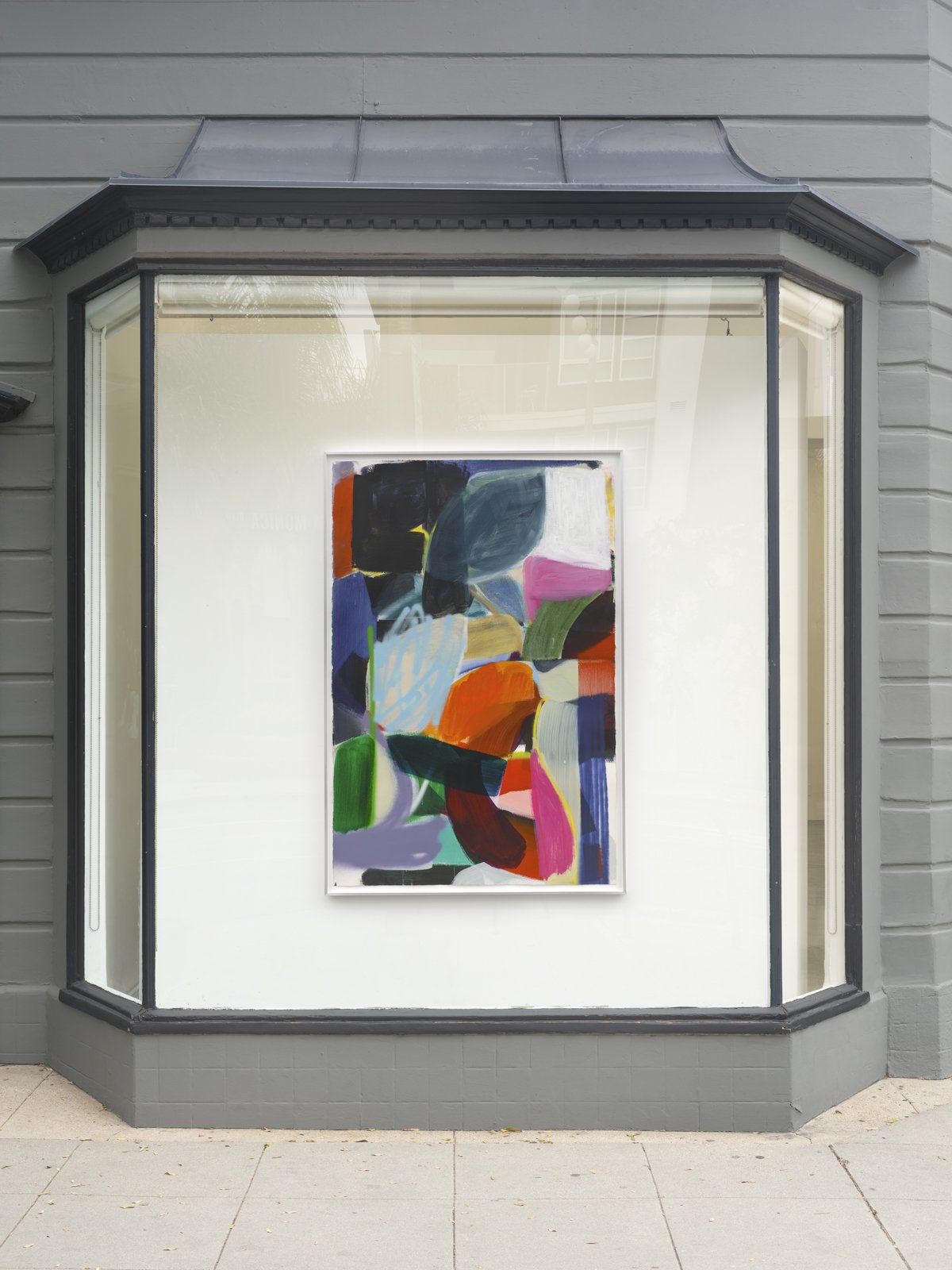Liliane Tomasko: Portrait of the Self
Nino Mier Gallery Los Angeles
June 3 through August 12, 2023
Exhibition Review by Raphy Sarkissian
Drawing gives a being form; color gives it life.[1]
—Denis Diderot
During the dream itself we do not leave the world behind: the dream space is segregated from the space of clear thinking, but it uses all the latter’s articulations. The world obsesses us even during sleep, and it is about the world that we dream.[2]
—Maurice Merleau-Ponty
Portrait of the Self, the inaugural solo exhibition of Liliane Tomasko at Nino Mier Gallery in Los Angeles, comprises an absorbing suite of large-scale paintings and works on paper that embody webs of virtuosic gestural brushwork rendered in an expansive range of crepuscular and vibrant hues. An assured compositional dynamic prevails these airy, painterly and lyrical abstractions executed by means of the graceful spontaneity of the artist’s hand. Through the medium of acrylic and acrylic spray, Tomasko has transformed planar surfaces into illusive spaces replete with chromatic translucence, chance and volatility. Upon these painterly planes, indexical links between bodily gesture and pictorial mark give way to kaleidoscopic realms that spawn restless interplays between interiority and exteriority, between the body and the world outside, between the conscious self and the unconscious. As noted in the gallery’s press release, Tomasko now “presents the latest installment in her more recent investigation of immaterial reality: dreams, reveries, and their shaping of inner life.”
Liliane Tomasko, Portrait of the Self, installation view. © Liliane Tomasko. Photo: courtesy of the artist and Nino Mier Gallery.
These recently realized abstractions of Tomasko extend the trajectory of a highly prolific career whose aim has been to probe through identifiable and unidentifiable images the nature of dreams, the self, the lucidity and opacity of knowledge, the abyss of human consciousness and culture’s epistemological boundaries. As Tomasko has emblematically noted on the occasion of her momentous exhibition Name Me Not held recently at the Caja de Burgos Art Center in Spain, “The subconscious is, to say the least, a shifty beast, and it does not want to be reasoned with, or conquered, but wants us to acknowledge its existence, and to listen to its song, to engage with it and give it a voice.”[3]
Liliane Tomasko, Portrait of the Self (frantically rearranging its parts), 2023. Acrylic and acrylic spray on aluminum, 76 by 70 inches. © Liliane Tomasko. Photo: courtesy of the artist and Nino Mier Gallery.
With its entrancing coloration and overall organization of sinuous forms, Tomasko’s Portrait of the Self (frantically rearranging its parts) (2023) recalls the compositional sensibility of Willem de Kooning’s Whose Name Was Writ in Water (1975) of the Guggenheim Museum of Art. Yet the acrobatic arabesques of Tomasko’s fluid sweeps connect the painting more closely to de Kooning’s Untitled 5 (1982) of the Museum of Modern Art in New York. The broad and brisk brushstrokes of Tomasko also bring to mind de Kooning’s Villa Borghese (1960) of the Guggenheim, for example, as if her painting were an homage to the modernist master. Raw and refined through a fully contemporary sensibility, this recently formulated visual syntax of Tomasko thus pays tribute to and breathes new life into the influential tradition of Abstract Expressionism.
Liliane Tomasko, COMPRESSION FEBRUARY, 2023. Acrylic and acrylic spray on paper, 62 ½ by 42 ½ by 1 ½ inches. © Liliane Tomasko. Photo: courtesy of the artist and Nino Mier Gallery.
For the past quarter of a century, Tomasko has steadily utilized the Polaroid photograph as a means of probing the phenomena of luminosity, color, space, architecture, unmade beds, mattresses, blankets, and pillows. Translating imagery of domestic objects and spaces into paintings through the mediums of oil and acrylic, Tomasko’s depiction of the physical world would be anchored to encompass the physiology, phenomenology and ontology of vision along with the experiences of dreams against the backdrop of modernity. “With each flutter of my eyelashes a curtain lowers and rises,” reflects Maurice Merleau-Ponty, granting one account of abstraction as an inherent condition of visual perception.[4] The phenomena of representation and nonrepresentation within a given Polaroid of Tomasko would become extended to her painterly practice. Works from the astonishing series of paintings titled Dissolution 2009-2013, Passage Crossing Over 2014, Hung Out to Dry 2015-2017 and A Dream of Hold on to Yourself 2018-2020, as reproduced in a monograph by Hatje Cantz in 2021, attest to a painterly practice that pairs abstraction and semblance as inseparable actualities in the process of seeing and its possibilities of pictorial representation. That monograph, Liliane Tomasko: We Sleep Where We Fall, also reveals Tomasko’s peculiar approach in naming the works, where the mechanics of capitalization amplifies the viewer’s attention to the possibilities of poetic interplays between a given title and a painting, between text and image.
Liliane Tomasko, COMPRESSION MAY 1, 2023, 2023. Acrylic and acrylic spray on paper, 62 ½ by 42 ½ by 1 ½ inches. © Liliane Tomasko. Photo: courtesy of the artist and Nino Mier Gallery.
In the current exhibition, the eleven works on aluminum are all titled Portrait of the Self, with distinct parenthetical subtitles that are stated in lowercase. There is a sense of metaphor, empathy, intellectualism, humor, arbitrariness and total inexplicability within the lowercase subtitles (using gray to amplify magenta), (staring right into questioning blues), (keeping things simple), (stormy yet optimistic), (dimming the light to see more clearly), (playing hide and seek), (taking shelter in the garden), (weaving itself into existence), (frantically rearranging its parts) and (at the centre, spinning yarns). The titular strategy of Tomasko for the ten paintings on paper, on the other hand, has been to fully capitalize them. While they all start with the word “compression” and are followed by a given month, three of them include specific days of month and year. Among the works executed on paper we encounter COMPRESSION SEPTEMBER; COMPRESSION OCTOBER; COMPRESSION NOVEMBER; COMPRESSION MARCH 25, 2023; COMPRESSION APRIL 28, 2023; and COMPRESSION MAY 1, 2023. Such preoccupations with temporality and language as counterparts of mark-making reveal Tomasko’s formulation of a practice wherein abstraction’s self-referentiality has been paradoxically halted. Addressing that dilemma, Kelly Grovier has incisively claimed, “Tomasko’s work vibrates with the pulse of shared allusion. These aren’t the retinal transcripts of a solipsistic experience but of something vital and universal. … She knows her art history, her formidable forebears, and, consciously or not, has created a series of works of remarkable elasticity in their dialogue with the past.”[5]
Liliane Tomasko, Portrait of the Self (keeping things simple), 2022. Acrylic and acrylic spray on aluminum, 76 by 70 inches. © Liliane Tomasko. Photo: courtesy of the artist and Nino Mier Gallery.
In Portrait of the Self (keeping things simple), gestural colors dance ceaselessly across the pictorial surface. Visceral reds robustly mask canary yellows and rich oranges in the center of the composition. Ultramarines firmly abut shades of pale blue on the upper right. Occupying the lower right of the picture surface, broad strokes of light forest greens have been largely veiled beneath a shroud of dark grey, black and brown sweeps. On the upper left, rhythmic brushstrokes in shades of purple are loosely circumscribed by a scarlet oval. Centrally, a vertical stripe in dark grey bisects the painting’s configuration, only to swerve almost horizontally toward the lower right. This slender band sets itself apart from the unnamable bodies of color hovering across the pictorial space. Suspended horizontally among spherical figures in the upper register of the composition, a dark bluish line segment gives way to a geometric order by acting as a counterpart of the vertical line, though the motif of the grid remains ancillary within a fluid space of seemingly irrational order and chromatic opulence. These colors and forms of Tomasko, while “keeping things simple,” offer us a portrait of an inner self, a self that is caught up between the visible and the invisible, a self that is engaged in the abstract realms of dreams and reveries.
Within the engrossing paintings and works on paper on view at Nino Mier Gallery, Tomasko’s highly layered and thinly modulated colors portray the viscosity, ethereality and volatility of dreams. These abstractions of Tomasko proclaim the unintelligibility of the subconscious, while inviting the spectator to bear in mind the “shifty beast” within us, “to acknowledge its existence, and to listen to its song, to engage with it and give it a voice.”
Notes
1. Denis Diderot, Diderot on Art, Volume I: The Salon of 1765 and Notes on Painting, trans. John Goodman (New Haven and London: Yale University Press, 1995), p. 196.
2. Maurice Merleau-Ponty, Phenomenology of Perception (1945), trans. Colin Smith (1962; reprint London: Routledge, 1995), p. 293.
3. Liliane Tomasko, first written in a statement for the opening of Evening Wind at the Hopper House Museum and Study Center, Nyack NY in March 2022, curated by Faye Fleming. Subsequently quoted in the exhibition catalogue Name Me Not for the exhibition held February 3 through May 28, 2023 at the Centro de Arte Caja de Burgos (Burgos: Fundación Caja de Burgos, 2023), p. 66.
4. Merleau-Ponty, The Visible and the Invisible (1964), ed. Claude Lefort, trans. Alphonso Lingis (1968; reprint Evanston: Northwestern University Press, 1985), p. 7.
5. Kelly Grovier, “A Faint Flicker in the Dark,” in Liliane Tomasko: We Sleep Where We Fall: Paintings 2000-2020 (Berlin: Hatje Cantz Verlag, 2021), p. 169.
“Raw and refined through a fully contemporary sensibility, this recently formulated visual syntax of Tomasko thus pays tribute to and breathes new life into the influential tradition of Abstract Expressionism.”
Liliane Tomasko, Portrait of the Self (frantically rearranging its parts), 2023. Acrylic and acrylic spray on aluminum, 76 by 70 inches. © Liliane Tomasko. Photo: courtesy of the artist and Nino Mier Gallery.
Willem de Kooning, Untitled V, 1982. Oil on canvas, 80 by 70 inches. © The Willem de Kooning Foundation / Artists Rights Society (ARS), New York. Photo: courtesy of the Museum of Modern Art.
Willem de Kooning. …Whose Name Was Writ in Water, 1975. Oil on canvas. 76 by 87 3/4 inches. © The Willem de Kooning Foundation/Artists Rights Society (ARS), New York. Photo: courtesy of the Guggenheim Museum.
Willem de Kooning. Villa Borghese, 1960. Oil on canvas, 79 15/16 by 70 1/16 inches © The Willem de Kooning Foundation/Artists Rights Society (ARS), New York. Photo: courtesy of the Guggenheim Museum.



